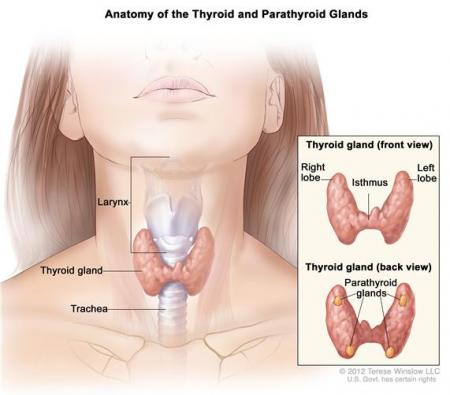Thyroid cancer is cancer that affects the thyroid gland, a small gland at the base of the neck. The most common symptom of cancer of the thyroid is a painless lump or swelling that develops in the neck. Other signs start occurring when the condition has reached an advanced stage, and may also include:
 unexplained hoarseness that lasts for more than a few weeks.
unexplained hoarseness that lasts for more than a few weeks.- a sore throat or difficulty swallowing that does not get better.
- a lump elsewhere in your neck.
It is important to remember that if you have a lump in your thyroid gland, it does not necessarily mean you have thyroid cancer. About 1 in 20 thyroid lumps are cancerous.
The Thyroid Gland
The thyroid gland consists of two lobes located on either side of the windpipe. Its main purpose is to release hormones (chemicals that have powerful effects on many different functions of the body).
The thyroid gland releases three separate hormones:
- Triiodothyronine – known as T3
- Thyroxine – known as T4
- Calcitonin
The T3 and T4 hormones help regulate the body’s metabolic rate (the rate at which the various processes in the body work, such as how quickly calories are burnt).
An excess of T3 and T4 will make you feel overactive, and you may lose weight. If you do not have enough of these hormones, you will feel sluggish, and you may gain weight.
Calcitonin helps control blood calcium levels. Calcium is a mineral that performs some important functions, such as building strong bones.
Calcitonin is not essential for maintaining good health because your body also has other ways of controlling calcium.
Types of Thyroid Cancer
There are four main types of thyroid cancer. They are:
- Papillary carcinoma – this is the most common type, accounting for about 6 out of 10 (60%) cases; it usually affects people under the age of 40, particularly women.
- Follicular carcinoma – accounts for around 3 out of 20 (15%) cases of thyroid cancer and tends to affect older adults.
- Medullary thyroid carcinoma – accounts for between 5 and 8 out of every 100 diagnosed cases (5-8%). Unlike the other types of thyroid cancer, medullary thyroid carcinoma can run in families.
- Anaplastic thyroid carcinoma – this one is the most aggressive and rarest type of thyroid cancer. It generally affects older people at the age of 60 or above.
Follicular and Papillary carcinomas are constantly recognized as different thyroid cancers, and they are generally treated in the same way.
What causes Thyroid Cancer?
In most cases, the cause of thyroid cancer is unknown. However, certain things can increase your chances of developing the condition.
Risk factors for thyroid cancer include:
- Having a benign (non-cancerous) thyroid condition.
- A family history of thyroid cancer (in the case of medullary thyroid cancer).
- Having a Familial adenomatous polyposis.
- Acromegaly – a rare condition where the body produces too much growth hormone.
- Having a previous benign (non-cancerous) breast condition.
- Weight and Height.
- Radiation exposure.
Diagnosing Thyroid Cancer
A type of blood test known as a thyroid function test will measure the hormone levels in your blood and rule out or confirm other thyroid problems.
If nothing else seems to be causing the lump in your thyroid, fine-needle aspiration cytology (FNAC) is used.
Additionally, more testing may also be involved if the FNAC results are undetermined, or if more information is required to make the treatment more successful.
Treating Thyroid Cancer
Your recommended treatment plan will depend on the type and grade of your cancer, and whether a complete cure is realistically achievable.
Differentiated thyroid cancers (DTCs) treated using a combination of surgery to remove the thyroid gland (thyroidectomy). And also a kind of radiotherapy that eliminate rest of the cancer cells and prevents the return of thyroid cancer.
Medullary thyroid carcinomas spread rapidly than DTCs. Therefore it is important to remove any adjacent lymph nodes, as well as the thyroid gland.





